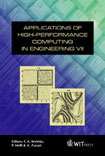Parallelization In Two-dimensional Direct Numerical Simulation
Price
Free (open access)
Volume
27
Pages
Published
2002
Size
432 kb
Paper DOI
10.2495/HPC020151
Copyright
WIT Press
Author(s)
Z. Yin, H. J. H. Clercx & D. C. Montgomery
Abstract
We are performing direct numerical simulation of two-dimensional (2D) Navier- Stokes turbulence at high Reynolds numbers (Re) in order to study some predictions from statistical mechanics. Two dimensions present some bottlenecks to parallelization that affect the current computations. We parallelize the code by distributing the major, time-consuming part of it within the time loop, assigning it to different CPU’s. The performance of our MPI Fortran90 code on the SGI Origin 3800 is reported. A few computational results relevant to the statistical-mechanical predictions are illustrated. 1 Background It has been known for several years that two-dimensional Navier-Stokes turbulence at high Reynolds numbers, as computed by spatially-periodic spectral-method codes, decays to long-lived states that are predictable to reasonable accuracy by statistical mechanical methods. The calculational technique is to assume an entropy functional and maximize it subject to the (approximate) conservation of total energy and total vorticity (of both signs). The resulting configuration is spatially non-uniform, approximately time- stationary, and involves only a few vortices. It involves a definite pointwise relation that is predicted between vorticity and stream function. Alternative versions of the theory differ in some respects. All are in some sense \“mean-field” theories, in which a continuous, differentiable, square-integrable, vorticity field results from the limit of discrete two-dimensional \“particles” of vorticity. The original version of the theory used zero-area \“point”
Keywords




